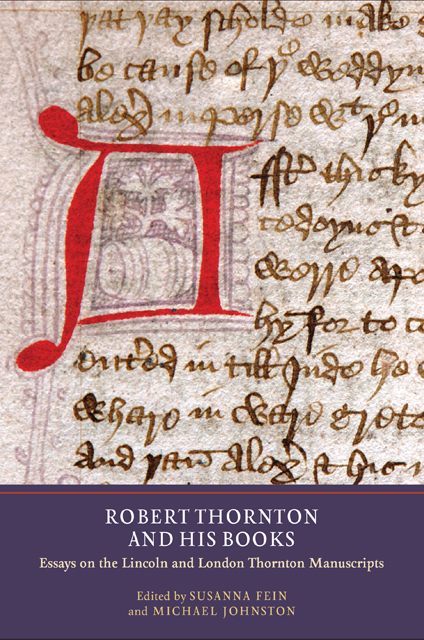Book contents
- Frontmatter
- Contents
- List of Illustrations
- List of Contributors
- Acknowledgements
- Abbreviations
- Introduction: The Cheese and the Worms and Robert Thornton
- 1 The Contents of Robert Thornton’s Manuscripts
- 2 Robert Thornton: Gentleman, Reader and Scribe
- 3 The Thornton Manuscripts and Book Production in York
- 4 The Text of the Alliterative Morte Arthure: A Prolegomenon for a Future Edition
- 5 ‘The rosselde spere to his herte rynnes’: Religious Violence in the Alliterative Morte Arthure and the Lincoln Thornton Manuscript
- 6 Constantinian Christianity in the London Thornton Manuscript: The Codicological and Linguistic Evidence of Thornton’s Intentions
- 7 Apocryphal Romance in the London Thornton Manuscript
- 8 Thornton’s Remedies and the Practices of Medical Reading
- Afterword: Robert Thornton Country
- Bibliography
- Index of Manuscripts Cited
- General Index
- York Medieval Press: Publications
2 - Robert Thornton: Gentleman, Reader and Scribe
Published online by Cambridge University Press: 28 February 2023
- Frontmatter
- Contents
- List of Illustrations
- List of Contributors
- Acknowledgements
- Abbreviations
- Introduction: The Cheese and the Worms and Robert Thornton
- 1 The Contents of Robert Thornton’s Manuscripts
- 2 Robert Thornton: Gentleman, Reader and Scribe
- 3 The Thornton Manuscripts and Book Production in York
- 4 The Text of the Alliterative Morte Arthure: A Prolegomenon for a Future Edition
- 5 ‘The rosselde spere to his herte rynnes’: Religious Violence in the Alliterative Morte Arthure and the Lincoln Thornton Manuscript
- 6 Constantinian Christianity in the London Thornton Manuscript: The Codicological and Linguistic Evidence of Thornton’s Intentions
- 7 Apocryphal Romance in the London Thornton Manuscript
- 8 Thornton’s Remedies and the Practices of Medical Reading
- Afterword: Robert Thornton Country
- Bibliography
- Index of Manuscripts Cited
- General Index
- York Medieval Press: Publications
Summary
The volume appears to have been a family book, and to have belonged to several persons of the name of Thornton.… This compilation must have formed a cyclopedia of amusement and instruction, when books were few and scarce.
Edward James Willson
The establishment of a private chapel in 1397 by the Thornton family of the manor of East Newton in Ryedale, Yorkshire, initiated a series of events that likely culminated in the copying of the two important and well-known Middle English miscellanies, Lincoln Cathedral Library, MS 91, and London, BL, MS Additional 31042. Piety and prosperity are the obvious explanations for the desire to establish this chapel. Apparently, the Thornton family had attained a sufficient level of prosperity to afford the costs of establishing and furnishing a chapel, where they could engage in celebration of formal liturgical exercises and also participate in exercises of individual piety. Such private chapels were common at the time, partly in response to a burgeoning desire among the laity to participate in private devotional exercises that were adapted from monastic spirituality.
With only the formulaic licence for the East Newton chapel and the testamentary evidence of Alice Thornton that it ‘was long since demolished’ in the seventeenth century, we have almost no basis for speculation about its original cost. It would surely not have been on the scale of the chapels built by the Multons of Frampton and their associates, but perhaps it was comparable to the modest chapel built by Humphrey Newton in the early sixteenth century. Such a chapel would certainly require furniture and, likely, vestments and sacred vessels, and probably wood or stone statues of the Virgin and the Christ and favourite saints. It is not impossible that the Thornton chapel had a wall painting, for the very beautiful wall paintings preserved at nearby Pickering church suggest that these were popular and may have been frequent in the churches of Ryedale. Imitating that style of decoration in a private chapel would seem a real possibility.
The chapel at East Newton was not only a sign of the family’s prosperity and piety, but a means to preserve them, for the chapel would have brought into the household, at least for temporary periods, a clergyman, perhaps a chantry priest from a nearby monastic institution, with some responsibility for the education of the young Robert Thornton.
- Type
- Chapter
- Information
- Robert Thornton and his BooksEssays on the Lincoln and London Thornton Manuscripts, pp. 67 - 108Publisher: Boydell & BrewerPrint publication year: 2014
- 1
- Cited by



